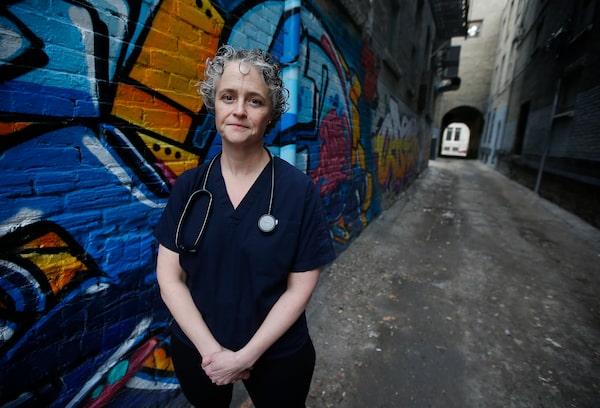
Carolyn Snider, an emergency physician at Winnipeg's Health Sciences Centre, is photographed in downtown Winnipeg on Nov. 23, 2018. Dr Snider has been hired as the head of the Emergency Department at St. Michael's Hospital in Toronto, Ont.JOHN WOODS/The Globe and Mail
Toronto’s St. Michael’s Hospital has hired a Winnipeg doctor as the new head of its busy emergency department. But Carolyn Snider is not new to the city or to this busy downtown hospital, where she cut her teeth as a medical resident.
And with alarms rising over the number of shootings in Toronto, her work back in Winnipeg with the Children’s Hospital Research Institute of Manitoba could take on new relevance in Canada’s largest city.
In Winnipeg, she launched a youth-violence study, modelled on similar projects in U.S cities, where outreach workers tried to help young victims of gang and other violence right after their treatment in the emergency room.
Its aim was to determine if a grim statistic could be reduced: More than 20 per cent of the young people who fall victim to violence face a return to hospital within a year. Her research found that the number was reduced to 13.7 per cent – and Dr. Snider tells The Globe and Mail’s Jeff Gray that she hopes to bring its lessons to St. Mike’s.
Tell me about why you launched this Emergency Department Violence Intervention Program (EDVIP) in Winnipeg
The start of the program really [had its origins] when I was at St. Michael’s Hospital and in Toronto during residency. I had an experience where I was working in the trauma room on a patient who I then recognized having treated a few months prior. The initial visit had been a minor stabbing, and I had quite a nice conversation with this young person. And he’d come back, shot. It hit him in the spine and he was paralyzed and was now a paraplegic.
I was really struck by the fact that I hadn’t been given the tools as an emergency physician yet on how to, not just to treat the physical injury but how to try to avoid a future visit. When we think of some of the other common things that we treat in the emergency department, somebody with chest pain, well we’re given all sorts of tools to try and avoid a next visit for a potential heart attack. The same with things like stroke, and high blood pressure. But in violent injury, we weren’t being taught those tools.
Your model focuses on the victim. Many people would say the problem must be the person who actually did the violence, not the victim in hospital
I see violence as a public-health issue. And we know that there is some, not entirely, but there is some overlap between victim and perpetrator in some cases. So by acknowledging the victim and the risk factors that they face, we can try to affect that piece. The other piece is that, we are in the health-care system, that is where we have access to potential youth that are at risk. It is important for us to take advantage of the opportunity that we have to make an impact.
Often you hear police say that a victim is not co-operating. I assume that victim might not want to talk to an outreach worker, either
Many of the youth will still feel they are putting themselves at risk if they do talk to the police. They don’t see themselves at risk for having a support worker that’s hooked up with them in the hospital, necessarily. Especially once that support worker has developed a significant trusting relationship. And the way that we do that is the support worker is there at the foot of the bed when the young person is in the emergency department or up on the trauma floor waking up.
It must be hard for outreach workers to talk to someone when they have just been shot or stabbed
In that moment, people are in a very reflective, receptive state of mind. One of the guys who was involved in helping us develop our program had been a former gang member himself. He spoke of his time in hospital, when he had been stabbed in the arm, quite badly. He was there as a victim, he wasn’t under arrest. The police had taken all of his clothes with them as part of the evidence, and he was lying in the bed, stitched up. And essentially, the hospital said, “Okay, you can go now.” The only people he had to call were his gang-member friends. He said, if only at that moment, somebody had said, “There’s another option, let me help you find another safe place to go.”
This interview has been edited and condensed.
 Jeff Gray
Jeff Gray